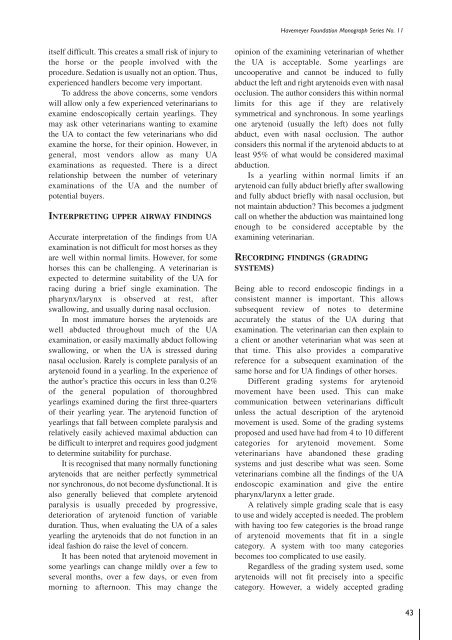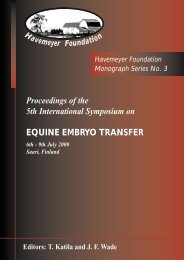Proceedings of a Workshop on - The Havemeyer Foundation
Proceedings of a Workshop on - The Havemeyer Foundation
Proceedings of a Workshop on - The Havemeyer Foundation
Create successful ePaper yourself
Turn your PDF publications into a flip-book with our unique Google optimized e-Paper software.
<strong>Havemeyer</strong> Foundati<strong>on</strong> M<strong>on</strong>ograph Series No. 11<br />
itself difficult. This creates a small risk <str<strong>on</strong>g>of</str<strong>on</strong>g> injury to<br />
the horse or the people involved with the<br />
procedure. Sedati<strong>on</strong> is usually not an opti<strong>on</strong>. Thus,<br />
experienced handlers become very important.<br />
To address the above c<strong>on</strong>cerns, some vendors<br />
will allow <strong>on</strong>ly a few experienced veterinarians to<br />
examine endoscopically certain yearlings. <strong>The</strong>y<br />
may ask other veterinarians wanting to examine<br />
the UA to c<strong>on</strong>tact the few veterinarians who did<br />
examine the horse, for their opini<strong>on</strong>. However, in<br />
general, most vendors allow as many UA<br />
examinati<strong>on</strong>s as requested. <strong>The</strong>re is a direct<br />
relati<strong>on</strong>ship between the number <str<strong>on</strong>g>of</str<strong>on</strong>g> veterinary<br />
examinati<strong>on</strong>s <str<strong>on</strong>g>of</str<strong>on</strong>g> the UA and the number <str<strong>on</strong>g>of</str<strong>on</strong>g><br />
potential buyers.<br />
INTERPRETING UPPER AIRWAY FINDINGS<br />
Accurate interpretati<strong>on</strong> <str<strong>on</strong>g>of</str<strong>on</strong>g> the findings from UA<br />
examinati<strong>on</strong> is not difficult for most horses as they<br />
are well within normal limits. However, for some<br />
horses this can be challenging. A veterinarian is<br />
expected to determine suitability <str<strong>on</strong>g>of</str<strong>on</strong>g> the UA for<br />
racing during a brief single examinati<strong>on</strong>. <strong>The</strong><br />
pharynx/larynx is observed at rest, after<br />
swallowing, and usually during nasal occlusi<strong>on</strong>.<br />
In most immature horses the arytenoids are<br />
well abducted throughout much <str<strong>on</strong>g>of</str<strong>on</strong>g> the UA<br />
examinati<strong>on</strong>, or easily maximally abduct following<br />
swallowing, or when the UA is stressed during<br />
nasal occlusi<strong>on</strong>. Rarely is complete paralysis <str<strong>on</strong>g>of</str<strong>on</strong>g> an<br />
arytenoid found in a yearling. In the experience <str<strong>on</strong>g>of</str<strong>on</strong>g><br />
the author’s practice this occurs in less than 0.2%<br />
<str<strong>on</strong>g>of</str<strong>on</strong>g> the general populati<strong>on</strong> <str<strong>on</strong>g>of</str<strong>on</strong>g> thoroughbred<br />
yearlings examined during the first three-quarters<br />
<str<strong>on</strong>g>of</str<strong>on</strong>g> their yearling year. <strong>The</strong> arytenoid functi<strong>on</strong> <str<strong>on</strong>g>of</str<strong>on</strong>g><br />
yearlings that fall between complete paralysis and<br />
relatively easily achieved maximal abducti<strong>on</strong> can<br />
be difficult to interpret and requires good judgment<br />
to determine suitability for purchase.<br />
It is recognised that many normally functi<strong>on</strong>ing<br />
arytenoids that are neither perfectly symmetrical<br />
nor synchr<strong>on</strong>ous, do not become dysfuncti<strong>on</strong>al. It is<br />
also generally believed that complete arytenoid<br />
paralysis is usually preceded by progressive,<br />
deteriorati<strong>on</strong> <str<strong>on</strong>g>of</str<strong>on</strong>g> arytenoid functi<strong>on</strong> <str<strong>on</strong>g>of</str<strong>on</strong>g> variable<br />
durati<strong>on</strong>. Thus, when evaluating the UA <str<strong>on</strong>g>of</str<strong>on</strong>g> a sales<br />
yearling the arytenoids that do not functi<strong>on</strong> in an<br />
ideal fashi<strong>on</strong> do raise the level <str<strong>on</strong>g>of</str<strong>on</strong>g> c<strong>on</strong>cern.<br />
It has been noted that arytenoid movement in<br />
some yearlings can change mildly over a few to<br />
several m<strong>on</strong>ths, over a few days, or even from<br />
morning to afterno<strong>on</strong>. This may change the<br />
opini<strong>on</strong> <str<strong>on</strong>g>of</str<strong>on</strong>g> the examining veterinarian <str<strong>on</strong>g>of</str<strong>on</strong>g> whether<br />
the UA is acceptable. Some yearlings are<br />
uncooperative and cannot be induced to fully<br />
abduct the left and right arytenoids even with nasal<br />
occlusi<strong>on</strong>. <strong>The</strong> author c<strong>on</strong>siders this within normal<br />
limits for this age if they are relatively<br />
symmetrical and synchr<strong>on</strong>ous. In some yearlings<br />
<strong>on</strong>e arytenoid (usually the left) does not fully<br />
abduct, even with nasal occlusi<strong>on</strong>. <strong>The</strong> author<br />
c<strong>on</strong>siders this normal if the arytenoid abducts to at<br />
least 95% <str<strong>on</strong>g>of</str<strong>on</strong>g> what would be c<strong>on</strong>sidered maximal<br />
abducti<strong>on</strong>.<br />
Is a yearling within normal limits if an<br />
arytenoid can fully abduct briefly after swallowing<br />
and fully abduct briefly with nasal occlusi<strong>on</strong>, but<br />
not maintain abducti<strong>on</strong>? This becomes a judgment<br />
call <strong>on</strong> whether the abducti<strong>on</strong> was maintained l<strong>on</strong>g<br />
enough to be c<strong>on</strong>sidered acceptable by the<br />
examining veterinarian.<br />
RECORDING FINDINGS (GRADING<br />
SYSTEMS)<br />
Being able to record endoscopic findings in a<br />
c<strong>on</strong>sistent manner is important. This allows<br />
subsequent review <str<strong>on</strong>g>of</str<strong>on</strong>g> notes to determine<br />
accurately the status <str<strong>on</strong>g>of</str<strong>on</strong>g> the UA during that<br />
examinati<strong>on</strong>. <strong>The</strong> veterinarian can then explain to<br />
a client or another veterinarian what was seen at<br />
that time. This also provides a comparative<br />
reference for a subsequent examinati<strong>on</strong> <str<strong>on</strong>g>of</str<strong>on</strong>g> the<br />
same horse and for UA findings <str<strong>on</strong>g>of</str<strong>on</strong>g> other horses.<br />
Different grading systems for arytenoid<br />
movement have been used. This can make<br />
communicati<strong>on</strong> between veterinarians difficult<br />
unless the actual descripti<strong>on</strong> <str<strong>on</strong>g>of</str<strong>on</strong>g> the arytenoid<br />
movement is used. Some <str<strong>on</strong>g>of</str<strong>on</strong>g> the grading systems<br />
proposed and used have had from 4 to 10 different<br />
categories for arytenoid movement. Some<br />
veterinarians have aband<strong>on</strong>ed these grading<br />
systems and just describe what was seen. Some<br />
veterinarians combine all the findings <str<strong>on</strong>g>of</str<strong>on</strong>g> the UA<br />
endoscopic examinati<strong>on</strong> and give the entire<br />
pharynx/larynx a letter grade.<br />
A relatively simple grading scale that is easy<br />
to use and widely accepted is needed. <strong>The</strong> problem<br />
with having too few categories is the broad range<br />
<str<strong>on</strong>g>of</str<strong>on</strong>g> arytenoid movements that fit in a single<br />
category. A system with too many categories<br />
becomes too complicated to use easily.<br />
Regardless <str<strong>on</strong>g>of</str<strong>on</strong>g> the grading system used, some<br />
arytenoids will not fit precisely into a specific<br />
category. However, a widely accepted grading<br />
43








